By Eric Vasallo
Editor’s Note: For decades, archaeologists and Egyptologists have wondered, theorized and ruminated about the whereabouts of the elusive tomb of ancient Egypt’s queen Nefertiti, wife of Akhenaten and, for a short time, ruler of Egypt after Akhenaten’s demise. One theory has recently emerged to excite the imagination of many ancient Egypt enthusiasts. But it has also generated scholarly doubt. The basis of this theory lies in a common ancient Egyptian practice…………
November 6th 2022, Luxor, Egypt — Scholars and officials gather at the Sonesta St. George hotel. At this location, it is one of only a few tall buildings overlooking the Nile river. They are attending a centennial celebration commemorating 100 years since the discovery of King Tutankhamun’s tomb, an event hosted by the American Research Center in Egypt (ARCE) and Egypt’s Ministry of Antiquities. Just across the river, Asasif mountain and Queen Hatsepsut’s temple reflect the last rays of the sun. Inside the hotel, Dr. Nicholas Reeves began presenting his paper. He is an archaeologist, Egyptologist, a former curator at the British Museum’s department of Egyptian Antiquities, and a former curator of Egyptian Art at the Metropolitan Museum of Art, credentials not unlike many of the others who sat in anticipation within this large meeting room.
As Reeves spoke, the room fell intensely silent, occasionally interrupted by murmurs and quiet gasps. The theory he was about to present follows a thread begun decades before by Howard Carter, who believed there was another hidden chamber inside or adjacent to Tut’s tomb — an arrangement not uncommon among other tombs of the early 18th dynasty. In fact, early on in the great discovery, Carter and others on his team speculated that his tomb might actually be a cache containing burials of several Amarna family members, instead of a tomb for one.
A Re-used Tomb
In 2015, Reeves published the tantalizing theory based on Factum Arte’s high-resolution scans, claiming there were two rooms hidden behind the northern and western walls inside the burial vault of Tutankhamun. Reeves posited the existence of two hidden chambers, perhaps still undisturbed, and that the tomb was originally created for someone else, not Tutankhamun. The evidence Reeves presents revolves around signs that Tutankhamun’s tomb is actuality a ‘re-used’ tomb, altered to fit Tutankhamun from what was first intended for his queen step-mother, Nefertiti.

In the final day of this (the Tut Centennial) event, Reeves showed multiple, concrete examples of ‘re-use’ or alteration among Tut’s tomb assemblage and iconography.
The newly discovered evidence of re-use include:
The nested shrines – Reveal a suppressed feminine glyph modified to a male grammatical form on the cartouches. Initially, Rex Engelbach noted this, then Marc Gabolde and Nicholas Reeves.
Tut’s red quartzite exterior sarcophagus – Observations made by Marianne Eaton-Krauss reveal multiple instances of adaptation from previous hieroglyphic signs that have been erased and re-carved alongside the sarcophagus exterior. Also, there are more substantial changes to the iconography which include addition of kingly wings to the goddess figures arms enfolding the four corners of the sarcophagus — a change easily interpreted as an upgrade for kingly use, covering over earlier, sub-pharaonic iconography.
Figures within the burial assemblage – Representations of female figures (hips, breasts) instead of the male figures expected for a king’s tomb are found multiple times — from the Tutankhamun statue riding a leopard through the Underworld to the gilded Duamutef figure and wooden shawabti.
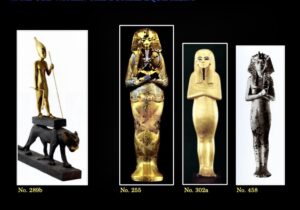
The nested coffins – Combinations of pharaonic and sub-pharaonic iconography are found in the outermost coffin. The headdress on this coffin displays an amalgamation of a kingly, khat style headdress over a tripartite wig traditionally worn by a queen.
____________________
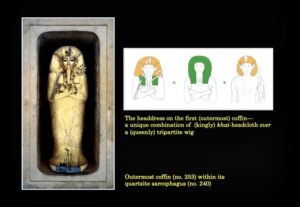
____________________
The coffinettes – More female to male re-use was shown on the exterior of Tut’s canopic coffinettes. The four coffinettes containing his organs all bear a rishi feathered design more typically reserved for queenly objects. Additionally, one of the coffinettes bears a concealed inscription on its interior near the right shoulder. The partially overwritten name inside a cartouche differs from one on Tut’s golden mask which reads “beloved of Neferkheperure” (aka Akhenaten). Instead, this coffinette reveals an original inscription that reads, “Neferneferuaten – she who is beneficial for her husband”. This previous inscription positively identifies the original owner of this funerary object was Akhenaten’s former principal wife, Queen Nefertiti. Neferneferuaten is the king name she is presumed to have adopted while she ruled briefly after his death. Incredibly, this exact same epithet appears again beneath the nomen of Tutankhamun on a pectoral jewel (no. 261p1) discovered in the Treasury.
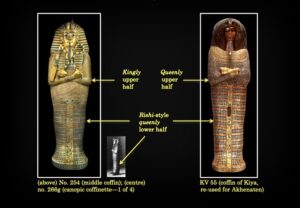
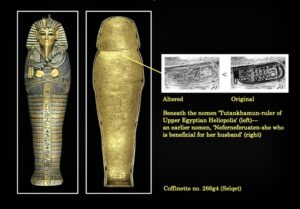
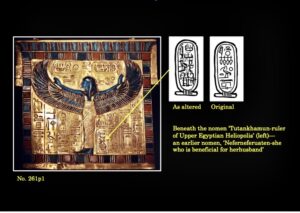
Tut’s mummy bands – A neutral, ungendered designation is found on the flanking gold bands (no. 256b4) decorating his mummy. The translation reads “beloved of Waenre”. Also, on the golden scarab suspension (no. 256a2) there is evidence of original manufacture for (but not actual use by) co-regent Neferneferuaten (Nefertiti). From the scarab down to the ankle area miscellaneous pieces were inscribed for Neferneferuaten. As is with a large portion of Tutankhamun’s core burial equipment, these objects were secondhand.
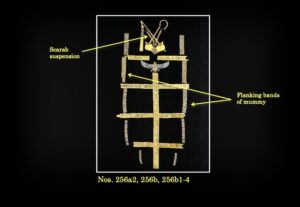
Tut’s Golden Throne – Three vertical strips of wood supporting the back show crucial evidence of alteration on Tut’s Golden Throne (no. 91). Slight traces within and beneath the inlaid gold-leaf foil sufficiently demonstrate that the throne, prepared originally for Nefertiti as queen, had been modified on several occasions and in a sequence which reflects the actual order of rule: Akhenaten as sole king then Akhenaten + Neferneferuaten (= Nefertiti as co-regent) followed by Smenkhkare (= Nefertiti as independent ruler) and finally, Tutankhaten/Tutankhamun. More evidence of re-use is found on other areas of the Throne, as well.
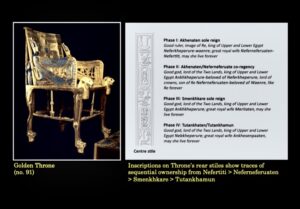
Wall decorations – Cartouches of Ay found painted on the tomb’s walls reveal a previous inscription bearing the name of Tutankhamun performing the funerary ritual for the tomb’s original owner – Nefertiti. Using Nefertiti’s bust profile onto the burial chamber walls portraying Tut in the form of Osiris, show a match for Nefertiti instead of Tutankhamun. The same was found for the face of Osiris on the exterior left-hand door of Tut’s second gilded shrine – an exact match with Nefertiti’s profile, not Tut’s.
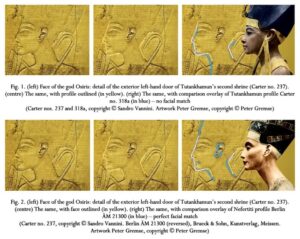
Thermal imaging – Reveals temperature anomalies inside Tut’s burial chamber in the area where a hidden doorway would be. Reeves also studied mold growth patterns that seemed to be concentrated in the area of a theorized hidden opening on the North Wall, behind the opening of the mouth mural.
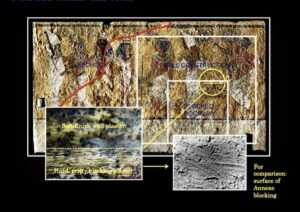

In his presentation, Reeves concludes – “Since the Egyptians were such consummate craftsmen, evidence of re-use is visible only in those rare works where adaptation had been carried out in a less than thorough manner. By the character and distribution of these sporadic, adapted pieces, it is nonetheless clear that the phenomenon of adaptation for re-use applies to Tutankhamun’s core burial equipment in its entirety. Shrines, sarcophagus, coffins, mask and canopic equipment—all had originally been intended for someone else, and, as texts and iconography reveal, for the use of Akhenaten’s great royal wife Nefertiti in her later role as the co-regent Ankhkheperure Neferneferuaten. Moreover, that this equipment had been available for Tutankhamun to take over wholesale would indicate that, following its manufacture, the material had gone unused by Neferneferuaten and placed directly into storage—most likely because, in the end, the lady had had access to something significantly better.”
The Debate
Egyptologists rarely have unanimous agreement on any one thing. This is no less true for the Reeves theory. Below are telling examples of reactions to Nicholas Reeves’ theory by top Egyptologists:
Zahi Hawass – “Why should we drill a hole and damage the tomb for a theory that few believe in?”
Salima Ikram – “There are so many holes in his theory for me to support his theory at this time. I would love it for it to be true. I have seen tomb orientations not corresponding to a king or queen. We are talking about a time period when there is a change in architecture. Most of the findings have alternative scenarios. Maybe there is a more direct way technicians could run a scan where Nicholas says the door is with three different teams to confirm…maybe? Drilling can be problematic as who determines how far you should go, etc?”
Factum Arte’s Aliaa Ismail – “It would be a discovery matching King Tutankhamun’s in wealth of goods and the information learned from her tomb would transform Egyptology even further. However, if we drill a hole to see what is behind, however small it may cause a crack in the wall and cause severe damage over time. So, it’s best to wait and see if the scanning technology improves and we can have more proof. I would love nothing more than to have Nefertiti’s tomb discovered. It would be yet another magnificent discovery that would equal or exceed King Tutankhamun’s.”
Dr. Betsy Bryan – Egyptologist and professor at Johns Hopkins University – “I would like to believe in fairy tales…I’d need to see more evidence.”
Marianne Eaton-Krauss – “Should there be hidden chambers in KV 62 they will contain additional equipment for Tutankhamun’s use in the hereafter, not the burial of Queen Nefertiti.”
Bob Brier – Believes it’s a “long shot” and refers to the three previous GPR scans that did not find anything conclusive (Watanabe’s Japanese team, National Geographic & the University of Turin team).
Dr. Chris Naunton – “I think Nick has a tremendous eye for detail and is very thorough, methodical, and clear in the way he formulates his arguments. He has also made genuine advances in some of the most scrutinized and popular subjects within Egyptology including the royal mummy caches, Amarna period and Tutankhamun. On the question of the hidden chambers, I find his argument very well-reasoned and compelling. Tut’s tomb is odd – no question about that. It’s too small, and too simple. Tut’s early, unexpected death may explain this, and it seems very reasonable to suggest that what would become the tomb of Ay later on was originally being prepared for Tutankhamun and simply could not be made ready in time forcing the authorities to look for an alternative tomb elsewhere. So, what was KV 62 before it was prepared for Tut? The idea that it was a tomb that had already been used to receive other burial, and that it was (pharaoh) Nefertiti’s is very plausible. Is she still in there beyond the walls of the burial chamber? Perhaps, but the radar scans would seem to show that there is nothing more. What about the alterations to the artwork on the rear wall? There is evidently something very interesting there, but should we interpret those changes as Nick does (i.e. they originally showed Nefertiti and Tut, and were then modified so that Nefertiti became Tut, and Tut become Ay)? I am not an artist historian but others who are disagree with him on this. Were the cartouches similarly reworked? Again, I think it comes down to whether or not you can ’see’ the evidence and that’s very subjective. Nick says yes, others will say no. For me the radar scans and subsequent excavations in the area – seem to suggest there is nothing more to find. I suspect Nick will continue to make the case.”
Kara Cooney – Egyptologist, author and professor of Egyptian art and architecture at the University of California, Los Angeles- is “on board” with the theory and awaiting more scans.
Kara Cooney posits, it would be very telling to see if analysis of Factum Arte imaging inside Ay’s tomb would reveal more of Tut’s story and possibly reveal the reverse of what Reeves has found – such as cartouches painted to modify the tomb’s owner from Tut to Ay.
Hope remains alive for scanning technology to improve and allow for more powerful, non-invasive scans that can verify if Nicholas Reeves’ provocative theories are correct.
On the issue of the scans, Reeves details some of the problems with using this technology as a sole indicator – “What the English component of the third radar investigation (GPR IIIb, regrettably sidelined by the Turin team) would early conclude was sobering: that, as dependable as radar technology may be in regular, top-down use, when employed within the confines of a tomb chamber its potential is massively compromised by the multiplicity of reflections. What we should be starting to see – all of us – is that while radar within KV 62 may occasionally provide useful supporting evidence, very much less reliance may [should] be placed on this technology, used alone, ever generating results sufficiently “conclusive” to decide for – and certainly against – any archaeological prospect.”
Nonetheless, the collection of new supporting evidence Reeves has presented and also published in his latest book has emboldened him to keep pushing his bold theory that Tutankhamun was given a hasty burial in the front hallway of a hidden tomb of Nefertiti where other missing members of the royal Amarna family may also be found buried along with their queen.
When asked if there were plans to do more scans or drill a small hole in the wall where the doorway should be, Nicholas Reeves humbly replied with a shrug, “I’m just a desktop guy presenting evidence. It’s up to the Egyptian Ministry to decide if they’d like to explore further.”
The mystery can indeed be quickly answered if Egypt’s Ministry of Antiquities would approve drilling of a small exploratory hole and inserting a camera as was done previously with “Gantenbrink’s door” to discover what was behind the small door along the shaft inside the Great Pyramid at Giza. There is an unpainted area below the mural on the Tutankhamun burial chamber’s north wall that can be drilled without damaging the irreplaceable artwork above.
In any case, regardless of where on stands on the issue, Egyptology enthusiasts can read more of the latest evidence Reeves presented at the ARCE & Ministry of Antiquities Centennial in his new book – The Complete Tutankhamun: 100 Years of Discovery, to be published in early 2023.



